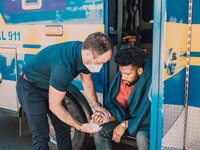RMTAO Blog
Massage Therapy for First Responders
BlogImage
First responders have an essential role in society. Professionals like firefighters, police officers and paramedics work hard to save lives, often at great personal risk to themselves. However, their important work often has a strain both on their bodies and on their mental health. Doctors and nurses in the emergency room often face similar physical and mental pressures. This article will outline the various ways massage therapy can help first responders and others in emergency services to manage their stresses and be physically able to continue their jobs without pain.
More than half of emergency nurses were found to experience extreme occupational stress often related to the types of accidents and injuries they see, and this rate is likely similar for other emergency responders. Research has found that massage therapy can promote physical relaxation responses, which can play a significant role in controlling this occupational stress. There are a variety of other factors that can contribute to mental health concerns that can impact first responders. Research suggests that there is a relationship between clinical insomnia and mental health disorders. More than two thirds of firefighters reported having below average sleep quality and lack of sleep can cause many physical and mental issues, including increased reports of low back pain. Massage therapy can make it easier to fall asleep and improve sleep quality for a wide variety of people.
Physical pain is also a common concern among first responders, as they often perform high risk, physically demanding tasks. Self-reported musculoskeletal pain has been found to be very common among firefighters, and the most common areas for injury are the upper and lower limbs, followed closely by the neck and back. Rotator cuff injuries are especially common early in a firefighter’s career. Massage therapy is an effective option to help people reduce their shoulder pain, back pain and other types of musculoskeletal pain, making it a great option for firefighters and other first responders in jobs more prone to this type of pain.
Many of these issues are also prevalent in Emergency Medical Technicians (EMTs). Musculoskeletal issues are common among EMTs, with back pain the most frequent complaint in this population. Routine EMT tasks put a strain on the back, which includes things like moving and transporting patients. EMTs are also susceptible to psychological distress due to the traumatizing situations they encounter. Depression and anxiety can be correlated with the intensity of back pain as well as absence from work due to pain. There is increasing evidence that massage therapy is an effective option for relieving both chronic and acute back pain.
First responders perform extremely important work, which can often damage their own physical and mental health. The musculoskeletal and psychological issues that come with the routine duties of their jobs can often keep first responders from work, which keeps them from helping people and doing what they love. Registered Massage Therapists (RMTs) can provide hands-on treatment and recommendations for remedial exercises that can help first responders keep doing the valuable work they love pain-free.
References
Castro-Sánchez, A.M., Matarán-Peñarrocha, G.A., Granero-Molina, J., Aguilera-Manrique, G., Quesada-Rubio, J.M., Moreno-Lorenzo, C. (2011). Benefits of massage-myofascial release therapy on pain, anxiety, quality of sleep, depression, and quality of life in patients with fibromyalgia. Evid Based Complement Alternat Med, 2011:561753.
Cherkin DC, Sherman KJ, Kahn J, Wellman R, Cook AJ, Johnson E, Erro J, Delaney K, Deyo RA. A comparison of the effects of 2 types of massage and usual care on chronic low back pain: a randomized, controlled trial. Ann Intern Med. 2011 Jul 5;155(1):1-9.
Field, T., Hernandes-Reif, M., Diego, M., Fraser, M. (2007). Lower back pain and sleep disturbance are reduced following massage therapy. J Bodyw Mov Ther, 11(2):141-145.
Jacobs, S., Mowbray, C., Cates, L.M., Baylor, A., Gable, C., Skora, E., et al. (2016). Pilot Study of Massage to Improve Sleep and Fatigue in Hospitalized Adolescents With Cancer. Pediatr Blood Cancer, 63(5):880-886.
Kumar, S., Beaton, K., & Hughes, T. (2013). The effectiveness of massage therapy for the treatment of nonspecific low back pain: a systematic review of systematic reviews. International journal of general medicine, 6, 733–741.
Mahdizadeh, M., Jaberi, A. A., & Bonabi, T. N. (2019). Massage Therapy in Management of Occupational Stress in Emergency Medical Services Staffs: a Randomized Controlled Trial. International journal of therapeutic massage & bodywork, 12(1), 16–22.
Miake-Lye, I. M., Mak, S., Lee, J., Luger, T., Taylor, S. L., Shanman, R., Beroes-Severin, J. M., & Shekelle, P. G. (2019). Massage for Pain: An Evidence Map. Journal of alternative and complementary medicine (New York, N.Y.), 25(5), 475–502.
Negm, A., MacDermid, J., Sinden, K., D'Amico, R., Lomotan, M., & MacIntyre, N. J. (2017). Prevalence and distribution of musculoskeletal disorders in firefighters are influenced by age and length of Service. Journal of Military, Veteran and Family Health, 3(2), 33–41.
Rahimi, A., Vazini, H., Alhani, F., & Anoosheh, M. (2015). Relationship Between Low Back Pain With Quality of Life, Depression, Anxiety and Stress Among Emergency Medical Technicians. Trauma monthly, 20(2), e18686.
Yeun Y. R. (2017). Effectiveness of massage therapy for shoulder pain: a systematic review and meta-analysis. Journal of physical therapy science, 29(5), 936–940.
Zhang, M., Murphy, B., Cabanilla, A., & Yidi, C. (2021). Physical relaxation for occupational stress in healthcare workers: A systematic review and network meta-analysis of randomized controlled trials. Journal of occupational health, 63(1), e12243.


